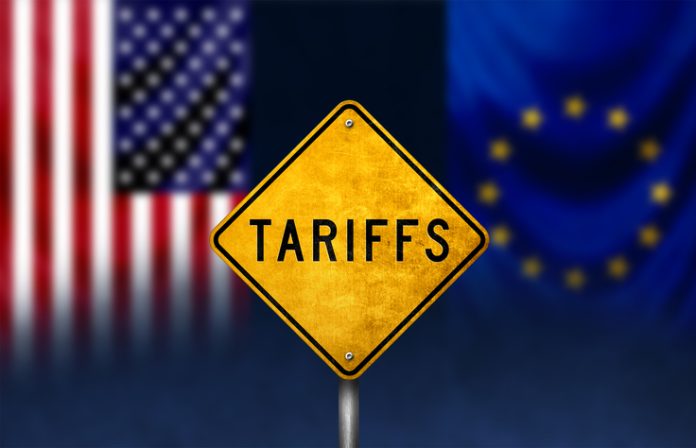By Dr Angela Garcia Calvo
As Europe (and the rest of the world) continues to navigate the daily twists and turns of President Trump’s recent tariff announcements, Dr Angela Garcia Calvo evaluates the options and outcomes for Europe’s next move. With a 90-day pause currently in place, what happens next could be make or break.
On April 2nd , President Trump announced a wide sweeping range of tariffs on most countries. Peter Navarro, Trump’s senior counsellor for trade and manufacturing, justified the measures as a long-overdue restructuring that “will make both the US and global economies more resilient and prosperous by restoring fairness and balance to a system rigged against America.”
The uncertainty and seemingly daily changes that followed the initial announcement have kept markets and businesses on their toes, with no clear conclusions on how the tariff tale might end. Stock markets have been on a rollercoaster ride, with a last-minute reprieve for some tech goods made with materials from China resulting in a market rebound. In recent days Sony has increased the price of its PlayStation 5 console in Europe, Britain, Australia and New Zealand, citing a challenging economic environment, inflation and fluctuating exchange rates.
Despite a current 90-day pause for nations hit by higher tariffs, how Europe reacts now will be crucial for long-term market stability.
Numerous experts have weighed in to assess the rationale behind Trump’s tariffs but less attention has been devoted to the question of how should Europe respond. I would argue that Europe should refrain from engaging in a tariff war. Instead the EU should focus on strengthening Europe’s industrial base, ensuring reliable access to inputs and critical technologies developed by others, and establishing chokepoints that enable Europe to avoid one-sided dependencies.
Let’s explore the possible approaches and outcomes further by examining Europe’s options.
1. Europe could respond to Trump’s tariffs with tariffs of its own. This would unleash an escalating war with no real winner and concrete casualties – namely consumers, workers and producers.
A tariff war would also cause deep intra-European splinters that could compromise Europe’s efforts to address existential industrial and security challenges. EU countries have very different production structures. Therefore, tariffs on a given set of goods/services will affect EU countries differently. Since the EU does not have a common fiscal system or a comprehensive redistribution mechanism to compensate losers, the effect would be to increase intra-European economic differences causing resentment and mistrust. In turn, this would undermine the broad-based consensus necessary to address the challenges identified by the Draghi and Letta reports on EU competitiveness and the Single Market. The outcome would be European stagnation and decline.
2. Alternatively, Europe could leverage the Commission’s regulatory capacity, especially when it comes to responding to the power of dominant US platform firms. The US would view this as a form of tariff worthy of retaliation, which brings us back to the previous option.
Further, targeting the platform economy would expose Europe’s own dependencies and possibly backfire. Platform firms provide essential services for economic, political and social life. Europe is entirely dependent on the services provided by US platform firms. In the face of regulatory measures that they deem punitive, private firms could decide to restrict their services or exit the EU altogether, leaving Europe to manage a 21st century economy, with 20th century tools. I dare you to imagine the impact of conducting economic activities via fax and feature phones, managing logistics without Google maps, conducting searches through physical libraries, or storing and managing data off the cloud.
3. The third option is to do nothing. However, in today’s unfolding scenarios, this is not feasible. As the Draghi report convincingly argues, if Europe stays on its current course, it will become poorer, politically unstable and irrelevant on the global stage. Trump’s tariffs will simply worsen the situation further.
4. This leaves us with one option: strengthen Europe’s industrial base, especially in the advanced, skill, capital-, and technology-intensive industries that are the main drivers of growth in advanced economies. Even in the most adverse scenario, this is the best guarantee that Europe can withstand external turbulences such as the announced US tariffs, exercise its political powers, and uphold its choices without external coercion.
Of course, this is a long-term strategy rather than a short-term reaction. Further, under the best of circumstances, Europe’s lack of natural resources and its dependence on technologies developed by others (especially the US), mean that Europe will continue to rely on relationships with other countries to access vital resources.
The key will be to develop points of leverage that enable Europe to avoid one-sided dependencies. Europe could do so by supporting the efforts of firms to establish themselves in chokepoints within industries that lay at the intersection of general purpose technologies which touch a broad range of economic activities, such as semiconductors or electric vehicles.
By establishing positions of durable advantage in specific stages within these important industries, Europe could exert a degree of power with which to project and protect its interests. On the whole this would be a more effective way for Europe to navigate the uncertain waters of today’s global economy than a tic-for-tac reaction, reliance on its regulatory capacity, or a passive approach.




































